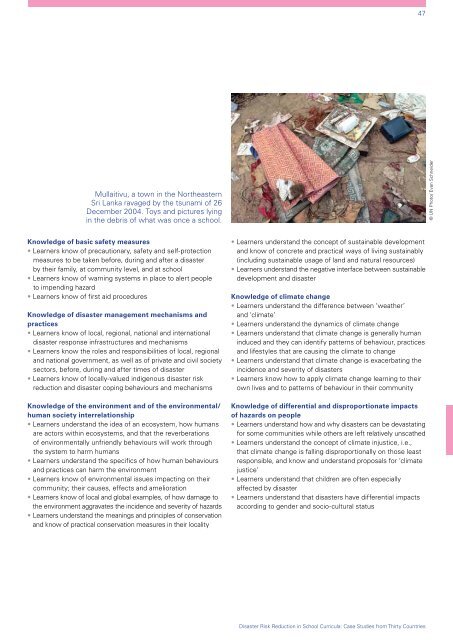Disaster Risk Reduction in School Curricula: Case Studies ... - Unicef
Disaster Risk Reduction in School Curricula: Case Studies ... - Unicef
Disaster Risk Reduction in School Curricula: Case Studies ... - Unicef
You also want an ePaper? Increase the reach of your titles
YUMPU automatically turns print PDFs into web optimized ePapers that Google loves.
47<br />
Mullaitivu, a town <strong>in</strong> the Northeastern<br />
Sri Lanka ravaged by the tsunami of 26<br />
December 2004. Toys and pictures ly<strong>in</strong>g<br />
<strong>in</strong> the debris of what was once a school.<br />
© UN Photo/ Evan Schneider<br />
Knowledge of basic safety measures<br />
Learners know of precautionary, safety and self-protection<br />
measures to be taken before, dur<strong>in</strong>g and after a disaster<br />
by their family, at community level, and at school<br />
Learners know of warn<strong>in</strong>g systems <strong>in</strong> place to alert people<br />
to impend<strong>in</strong>g hazard<br />
Learners know of first aid procedures<br />
Knowledge of disaster management mechanisms and<br />
practices<br />
Learners know of local, regional, national and <strong>in</strong>ternational<br />
disaster response <strong>in</strong>frastructures and mechanisms<br />
Learners know the roles and responsibilities of local, regional<br />
and national government, as well as of private and civil society<br />
sectors, before, dur<strong>in</strong>g and after times of disaster<br />
Learners know of locally-valued <strong>in</strong>digenous disaster risk<br />
reduction and disaster cop<strong>in</strong>g behaviours and mechanisms<br />
Knowledge of the environment and of the environmental/<br />
human society <strong>in</strong>terrelationship<br />
Learners understand the idea of an ecosystem, how humans<br />
are actors with<strong>in</strong> ecosystems, and that the reverberations<br />
of environmentally unfriendly behaviours will work through<br />
the system to harm humans<br />
Learners understand the specifics of how human behaviours<br />
and practices can harm the environment<br />
Learners know of environmental issues impact<strong>in</strong>g on their<br />
community; their causes, effects and amelioration<br />
Learners know of local and global examples, of how damage to<br />
the environment aggravates the <strong>in</strong>cidence and severity of hazards<br />
Learners understand the mean<strong>in</strong>gs and pr<strong>in</strong>ciples of conservation<br />
and know of practical conservation measures <strong>in</strong> their locality<br />
Learners understand the concept of susta<strong>in</strong>able development<br />
and know of concrete and practical ways of liv<strong>in</strong>g susta<strong>in</strong>ably<br />
(<strong>in</strong>clud<strong>in</strong>g susta<strong>in</strong>able usage of land and natural resources)<br />
Learners understand the negative <strong>in</strong>terface between susta<strong>in</strong>able<br />
development and disaster<br />
Knowledge of climate change<br />
Learners understand the difference between ‘weather’<br />
and ‘climate’<br />
Learners understand the dynamics of climate change<br />
Learners understand that climate change is generally human<br />
<strong>in</strong>duced and they can identify patterns of behaviour, practices<br />
and lifestyles that are caus<strong>in</strong>g the climate to change<br />
Learners understand that climate change is exacerbat<strong>in</strong>g the<br />
<strong>in</strong>cidence and severity of disasters<br />
Learners know how to apply climate change learn<strong>in</strong>g to their<br />
own lives and to patterns of behaviour <strong>in</strong> their community<br />
Knowledge of differential and disproportionate impacts<br />
of hazards on people<br />
Learners understand how and why disasters can be devastat<strong>in</strong>g<br />
for some communities while others are left relatively unscathed<br />
Learners understand the concept of climate <strong>in</strong>justice, i.e.,<br />
that climate change is fall<strong>in</strong>g disproportionally on those least<br />
responsible, and know and understand proposals for ‘climate<br />
justice’<br />
Learners understand that children are often especially<br />
affected by disaster<br />
Learners understand that disasters have differential impacts<br />
accord<strong>in</strong>g to gender and socio-cultural status<br />
<strong>Disaster</strong> <strong>Risk</strong> <strong>Reduction</strong> <strong>in</strong> <strong>School</strong> <strong>Curricula</strong>: <strong>Case</strong> <strong>Studies</strong> from Thirty Countries

















